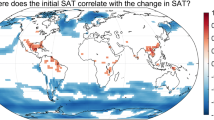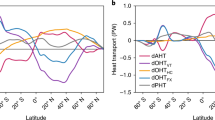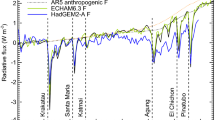Abstract
A version of the National Center for Atmospheric Research community climate model — a global, spectral (R15) general circulation model — is coupled to a coarse-grid (5° latitude-] longitude, four-layer) ocean general circulation model to study the response of the climate system to increases of atmospheric carbon dioxide (CO2). Three simulations are run: one with an instantaneous doubling of atmospheric CO2 (from 330 to 660 ppm), another with the CO2 concentration starting at 330 ppm and increasing linearly at a rate of 1% per year, and a third with CO2 held constant at 330 pm. Results at the end of 30 years of simulation indicate a globally averaged surface air temperature increase of 1.6° C for the instantaneous doubling case and 0.7°C for the transient forcing case. Inherent characteristics of the coarse-grid ocean model flow sea-surface temperatures (SSTs) in the tropics and higher-than-observed SSTs and reduced sea-ice extent at higher latitudes] produce lower sensitivity in this model after 30 years than in earlier simulations with the same atmosphere coupled to a 50-m, slab-ocean mixed layer. Within the limitations of the simulated meridional overturning, the thermohaline circulation weakens in the coupled model with doubled CO2 as the high-latitude ocean-surface layer warms and freshens and westerly wind stress is decreased. In the transient forcing case with slowly increasing CO2 (30% increase after 30 years), the zonal mean warming of the ocean is most evident in the surface layer near 30°–50° S. Geographical plots of surface air temperature change in the transient case show patterns of regional climate anomalies that differ from those in the instantaneous CO2 doubling case, particularly in the North Atlantic and northern European regions. This suggests that differences in CO2 forcing in the climate system are important in CO2 response in regard to time-dependent climate anomaly regimes. This confirms earlier studies with simple climate models that instantaneous CO2 doubling simulations may not be analogous in all respects to simulations with slowly increasing CO2.
Similar content being viewed by others
References
Alexander RC, Mobley RL (1976) Monthly average sea-surface temperatures and ice pack limits on a 1° global grid. Mon Weather Rev 104:143–148
Bates G, Meehl GA (1986) The effect of CO2 concentration on the frequency of blocking in a general circulation model coupled to a simple mixed layer ocean. Mon Weather Rev 114:687–701
Bourke W, McAvaney B, Puri K, Thurling R (1977) Global modeling of atmospheric flow by spectral methods. In: Chang J (ed) Methods in computational physics, general circulation models of the atmosphere. Academic Press, New York, pp 267–324
Bryan F (1986) High latitude salinity effects and interhemispheric thermohaline circulations. Nature 323:301–304
Bryan K (1969) Climate and the ocean circulation: III. The ocean model. Mon Weather Rev 97:806–827
Bryan K, Lewis LJ (1979) A water mass model of the world oceans. J Geophys Res 84:2503–2517
Bryan K, Spelman MJ (1985) The ocean's response to a carbon dioxide-induced warming. J Geophys Res 90:11679–11688
Bryan K, Komro FG, Manabe S, Spelman MJ (1982) Transient climate response to increasing atmospheric carbon dioxide. Science 215:56–58
Bryan K, Manabe S, Spelman MJ (1988) Interhemispheric asymmetry in the transient response of a coupled ocean-atmosphere model to a CO2 forcing. J Phys Oceanogr 18:851–867
Carissimo BC, Oort AH, Vonder Haar TH (1985) Estimating the meridional energy transport in the atmosphere and ocean. J Phys Oceanogr 15:82–91
Chervin RM (1981) On the comparison of observed and GCM simulated climate ensembles. J Atmos Sci 38:885–901
Cox MD (1975) A baroclinic numerical model of the world ocean: Preliminary results. Numerical Models of Ocean Circulation, National Academy of Science, Washington, DC, pp 107–120
Cox MD (1985) An eddy resolving numerical model of the ventilated thermocline. J Phys Oceanogr 15:1312–1324
Crutcher HL, Meserve JM (1970) Selected level heights, temperatures and dew points for the northern hemisphere. Rep NAVAIR 50–1C-52, Naval Weather Service Command, Washington, DC
Dickinson RE, Meehl GA, Washington WM (1987) Ice-albedo feedback in a CO2 doubling simulation. Climatic Change 10:241–248
Gates WL, Han YJ, Schlesinger ME (1985) The global climate simulated by a coupled atmosphere-ocean general circulation model: Preliminary results. In: Nihoul JCJ (ed) Coupled ocean-atmosphere models. Elsevier Oceanogr Ser 40:131–151
Han YJ (1984) A numerical world ocean general circulation model. Dyn Atmos Oceans 8:141–172
Hansen J, Lacis A, Rind D, Russell G, Stone P, Fung I, Ruedy R. Lerner J (1984) Climate sensitivity: Analysis of feedback mechanisms. In: Hansen JF, Takahashi T (eds) Climate processes and climate sensitivity. Maurice Ewing Series 5:130–163
Hansen J, Fung I, Lacis A, Rind D, Lebedeff S, Ruedy R, Russell G (1988) Global climate changes as forecast by Goddard Institute for Space Studies three-dimensional model. J Geophys Res 93:9341–9364
Hartmann DL, Ramanathan V, Berroir A, Hunt GE (1986) Earth radiation budget data and climate research. Rev Geophys 24:439–468
Hastenrath S (1980) Heat budget of tropical ocean and atmosphere. J Phys Oceanogr 10:159–170
Hellerman S, Rosenstein M (1983) Normal monthly wind stress data over the world ocean with error estimates. J Phys Oceanogr 13:1093–1104
Herman GF, Johnson WT (1978) The sensitivity of the general circulation to Arctic sea ice boundaries: A numerical experiment. Mon Weather Rev 106:1649–1664
Hsiung J (1985) Estimates of global oceanic meridional heat transport. J Phys Oceanogr 15:1405–1413
Jaeger L (1976) Monatskarten des Niederschlags fur die ganze Erde. Ber Dtsch Wetterd 139:38 pp
Knauss JA (1978) Introduction to Physical Oceanography. Prentice-Hall, Englewood Cliffs, NJ, 338 p
Levitus S (1982) Climatological Atlas of the World Ocean. NOAA Professional Paper 13, National Oceanic and Atmospheric Administration, Washington, DC, 173 p, 17 microfiche
Levitus S (1987) Rate of change of heat storage of the world ocean. J Phys Oceanogr 17:518–528
MacCracken MC, Luther FM (eds) (1985) Projecting the Climatic Effects of Increasing Carbon Dioxide. DOE/ER0237, United States Department of Energy, Washington, DC, 381 p
Manabe S (1969) Climate and the ocean circulation: I. The atmospheric circulation and the hydrology of the earth's surface. Mon Weather Rev 97:775–805
Manabe S, Stouffer RJ (1980) Sensitivity of a global climate model to an increase of CO2 concentration in the atmosphere. J Geophys Res 85:5529–5554
Manabe S, Stouffer RJ (1988) Two stable equilibria of a coupled ocean-atmosphere model. J Clim 1:841–866
Manabe S, Wetherald RT (1975) The effects of doubling the CO2 concentration on the climate of a general circulation model. J Atmos Sci 32:3–15
Manabe S, Smagorinsky J, Strickler RF (1965) Simulated climatology of a general circulation model with a hydrologic cycle. Mon Weather Rev 93:769–798
McAvaney BJ, Bourke W, Puri K (1978) A global spectral model for simulation of the general circulation. J Atmos Sci 35:1557–1582
Meehl GA (1984) A calculation of ocean heat storage and effective ocean surface-layer depths for the northern hemisphere. J Phys Oceanogr 14:1746–1760
Meehl GA (1988) Tropical -midlatitude interactions in the Indian and Pacific sectors of the southern hemisphere. Mon Weather Rev 116:472–484
Meehl GA (1989) The coupled ocean-atmosphere modeling problem in the tropical Pacific and Asian monsoon regions. J Climate (in press)
Meehl GA, Albrecht BA (1988) Tropospheric temperatures and southern hemisphere circulation. Mon Weather Rev 116:953–960
Meehl GA, Washington WM (1985) Sea surface temperatures computed by a simple ocean mixed layer coupled to an atmospheric model. J Phys Oceanogr 15:92–104
Meehl GA, Washington WM (1986) Tropical response to increased CO2 in a GCM with a simple mixed layer ocean: Similarities to an observed Pacific Warm Event. Mon Weather Rev 114:667–674
Meehl GA, Washington WM (1988) A comparison of soilmoisture sensitivity in two global climate models. J Atmos Sci 45:1476–1492
Meehl GA, Washington WM, Semtner AJ Jr (1982) Experiments with a global ocean model driven by observed atmospheric forcing. J Phys Oceanogr 12:301–312
Mitchell JFB, Hills TS (1986) Sea-ice and antarctic winter circulation: A numerical experiment. Q J R Meteorol Soc 112:953–969
National Research Council (1982) Carbon Dioxide and Climate: A Second Assessment, National Academy of Sciences, Washington, DC, 72 p
Newell RE, Kidson JW, Vincent DG, Boer GJ (1972) The General Circulation of the Tropical Atmosphere and Interactions with Extra-Tropical Latitudes, vol 1. M.I.T. Press, Cambridge, MA, 258 p
Oort AH (1983) Global atmospheric circulation statistics, 1958–1973. NOAA Professional Paper 13, National Oceanic and Atmospheric Administration, Washington, DC, 180 p
Oort AH, Vonder Haar TH (1976) On the observed annual cycle in the ocean-atmosphere heat balance over the Northern Hemisphere. J Phys Oceanogr 6:781–800
Parkinson CL, Comiso JC, Zwally HJ, Cavalier DJ, Gloersen P (1987) Arctic sea ice 1973–1976: Satellite passive-microwave observations. National Aeronautics and Space Administration, NASA SP-489, Washington, DC, 296 p
Philander SGH, Hurlin WJ (1988) The heat budget of the tropical Pacific Ocean in a simulation of the 1982–83 El Niño. J Phys Oceanogr 18:926–931
Philander SGH, Seigel AD (1985) Simulation of El Niño of 1982–1983. In: Nihoul JCJ (ed) Coupled ocean-atmosphere models. Elsevier Oceanogr Ser 40:517–541
Pitcher EJ, Malone RC, Ramanathan V, Blackmon ML, Puri K, Bourke W (1983) January and July simulations with a spectral general circulation model. J Atmos Sci 40:580–604
Ramanathan V (1981) The role of ocean-atmosphere interactions in the CO2 climate problem. J Atmos Sci 38:918–930
Ramanathan V, Pitcher EJ, Malone RC, Blackmon ML (1983) The response of a spectral general circulation model to refinements in radiative processes. J Atmos Sci 40:605–630
Rogers JC (1989) Seasonal temperature variability over the North Atlantic Arctic. Proc 13th Climate Diagnostics Workshop, U.S. Department of Commerce, Washington, pp 170–175
Rogers JC, van Loon H (1979) The seesaw in winter temperatures between Greenland and northern Europe. Part 11: Some oceanic and atmospheric effects at middle and high latitudes. Mon Weather Rev 107:509–519
Schlesinger ME, Jiang X (1988) The transport Of CO2-induced warming into the ocean: An analysis of simulations by the OSU coupled atmosphere-ocean general circulation model. Climate Dyn 3:1–17
Schlesinger ME, Mitchell JFB (1985) Model projections of equilibrium climatic response to increased carbon dioxide. In: MacCracken MC, Luther FM (eds) The Potential Climatic Effects of Increasing Carbon Dioxide. DOE/ER0237, United States Department of Energy, Washington, DC, pp 81–147
Schlesinger ME, Mitchell JFB (1987) Climate model simulations of the equilibrium climatic response to increased carbon dioxide. Rev Geophys 25:760–798
Schlesinger ME, Gates WL, Han YJ (1985) The role of the ocean in CO2-induced climate change: Preliminary results from the OSU coupled atmosphere-ocean general circulation model. In: Nihoul JCJ (ed) Coupled ocean-atmosphere models, Elsevier Oceanography Series 40:447–478
Schneider SH, Thompson SL (1981) Atmospheric CO2 and climate: Importance of transient response. J Geophys Res 86:3135–3147
Semtner AJ (1974) An oceanic general circulation model with bottom topography. Numerical Simulation of Weather and Climate, Tech Rep 9, University of California, Los Angeles, 99 p
Semtner AJ (1976) A model for the thermodynamic growth of sea ice in numerical investigations of climate. J Phys Oceanogr 6:379–389
Semtner AJ (1987) A numerical study of sea ice and ocean circulation in the Arctic. J Phys Oceanogr 17:1077–11099
Semtner AJ, Chervin RC (1988) A simulation of the global ocean circulation with resolved eddies. J Geophys Res 93:15502–15522
Semtner AJ, Mintz Y (1977) Numerical simulation of the Gulf Stream and mid-ocean eddies. J Phys Oceanogr 7:208–230
Spelman MJ, Manabe S (1984) Influence of oceanic heat transport upon the sensitivity of a model climate. J Geophys Res 89:571–586
Taljaard JJ, van Loon H, Crutcher HL, Jenne RL (1969) Climate of the upper air: Southern Hemisphere, Vol. 1, Temperature dew points and heights at selected pressure levels. NAVAIR 50-K-55, Chief Nav Oper, Washington, DC, 135 p
Thompson SL, Schneider SH (1982) Carbon dioxide and climate: The importance of realistic geography in estimating the transient temperature response. Science 217:1031–1033
Trenberth KE (1979) Mean annual poleward energy transports by the oceans in the southern hemisphere. Dyn Atmos Oceans 4:57–64
van Loon H, Taljaard JJ, Jenne RL, Crutcher HL (1971) Climate of the upper air: Southern Hemisphere, Vol 2, Zonal geostrophic winds. Tech Note STR-57, National Center for Atmospheric Research, Boulder, Colorado
Washington WM; Meehl GA (1983) General circulation model experiments on the climatic effects due to a doubling and quadrupling of carbon dioxide concentrations. J Geophys Res 88:6600–6610
Washington WM, Meehl GA (1984) Seasonal cycle experiment on the climate sensitivity due to a doubling of CO2 with an atmospheric general circulation model coupled to a simple mixed-layer ocean model. J Geophys Res 89:9475–9503
Washington WM, Meehl GA (1986) General circulation model CO2 sensitivity experiments: Snow-sea ice albedo parameterization and globally averaged surface air temperature. Climatic Change 8:231–241
Washington WM, Williamson DL (1977) A description of the NCAR global circulation models. In: Chang J (ed) Methods in Computational Physics 17, Academic Press, New York, pp 111–172
Washington WM, Semtner AJ, Meehl GA, Knight DJ, Mayer TA (1980) A general circulation experiment with a coupled atmosphere, ocean, and sea ice model. J Phys Oceanogr 10:1887–1908
Wilson CA, Mitchell JFB (1987) A doubled CO2 climate sensitivity experiment with a global climate model including a simple ocean. J Geophys Res 92:13315–13343
Author information
Authors and Affiliations
Additional information
A portion of this study is supported by the US Department of Energy as part of its Carbon Dioxide Research Program
Rights and permissions
About this article
Cite this article
Washington, W.M., Meehl, G.A. Climate sensitivity due to increased CO2: experiments with a coupled atmosphere and ocean general circulation model. Climate Dynamics 4, 1–38 (1989). https://doi.org/10.1007/BF00207397
Issue Date:
DOI: https://doi.org/10.1007/BF00207397




